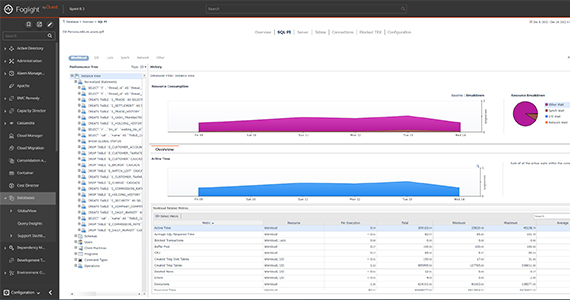Foglight for MySQL
Detect, diagnose and resolve performance issues across your MySQL environment. With Foglight for MySQL, you can quickly and easily detect, diagnose and resolve performance issues. Intuitive web-based dashboards alert you to emerging issues that might affect performance or availability, and a clear enterprise-wide view helps you optimize performance across all your physical, virtual and cloud-based MySQL database servers. The latest version offers SQL Performance Investigator for multidimensional analysis which provides deeper visibility into the most complex database performance challenges.

Your organization implemented MySQL because it’s a cost-effective, stable and scalable database option. However, introducing open source technology into your enterprise database can challenge DBAs like you to realize the benefits and cost savings that the platform can provide. What if you could proactively manage the health of your MySQL infrastructure while helping your organization realize the cost efficiency of leveraging open source databases? What if you could do this without sacrificing your ability to monitor and diagnose problems? Foglight® for MySQL addresses these and broader cross-platform needs. Make your job easier while you ensure the health and performance of your entire database environment.
Features
Global view
Review key health and performance metrics across all your monitored database instances from a single dashboard. Quickly identify the most critical alarms so you can immediately take action to resolve performance issues on your MySQL databases and their underlying hosts.
Lock analysis
Resolve MySQL concurrency issues in record time with historical reviews of lock and deadlock issues.
Replication
Visualize even the most complex replication environments, whether one-to-one or one-to-many. Receive alerts when replication breaks or lags.
Workload analysis and statement digests
Understand query performance with a complete breakdown of resource consumption, wait and lock times, row counts, and more using the SQL Performance Investigator (SQL PI) component of Foglight for MySQL.
Component visualization
Visualize the performance of critical server components and the underlying host. An interactive dashboard displays high-level server components and the flow of information between them, and alerts you when components operate outside normal ranges.
Table visualization
Visualize all tables for all your MySQL databases on a single screen, with table health and basic properties.
Server metrics
Understand server performance by category. Quickly identify issues affecting server components, and drill down to details for fast resolution.
InnoDB performance
Track performance indicators for InnoDB so you can allocate the correct amount of memory to your buffer pool, know if queries are waiting to enter InnoDB, understand how transactions affect InnoDB performance and more.
Centralized administration
Easily administer a large or distributed environment by managing connections, tables, flushes and resets centrally from any connected server. Ensure accountability with logs of all actions.
Intelligent alerting
Avoid false alerts with adaptive Intelliprofile thresholds, which ensure alarms are only triggered when baselines are breached. Easily manage and annotate alarms, including scheduling blackouts for maintenance periods.
Enterprise-scale monitoring
Monitor hundreds of MySQL servers from a single management server.
Low overhead
Execute data collection through remote agents that ensure minimal overhead (no more than 2% CPU) is added to monitored database instances.
High granularity
Ensure high-integrity data collection with frequent collections, or customize collection frequency to meet your business requirements.
Embedded repository
Store historical monitoring data in the embedded data warehouse — without needing to purchase or install additional database instances for storage of monitoring data. External repositories can be leveraged in larger deployments.
Specifications
- MySQL 5.0 and above
- MariaDB 5.0 and above
- On-premises
- Cloud deployments
- Azure MySQL
- Aurora MySQL
- Amazon RDS
- Foglight Management Server (FMS) 5.7.5 or higher
Resources
Foglight for MySQL
Proactively manage the health and performance of your MySQL database infrastructure.
The Importance of Continuous Monitoring in a DevOps Pipeline
A common challenge in many IT teams is the “blame game” where developers blame DBAs for stability and performance issues and v...
Tools for the Evolving Database Administrator
Databases evolve fast and smart database administrators (DBAs) evolve even faster. As the landscape shifts from reliance on rel...
Financial services company boosts the business value of databases
AmTrust Financial Services monitors and improves database performance by relying on Quest® Foglight® software to deliver action...
Foglight Skills 101- What's New in Foglight (GMT)
Unlock the future of database and infrastructure monitoring by joining us for an exclusive webinar showcasing the groundbreakin...
Foglight Skills 101- What's New in Foglight (EST)
Unlock the future of database and infrastructure monitoring by joining us for an exclusive webinar showcasing the groundbreakin...
Foglight Essentials: The Importance and Process of Upgrading (EST)
Join us for webinar where we discuss effective strategies to seamlessly upgrade your Foglight while avoiding the mistakes many ...
Foglight Essentials: The Importance and Process of Upgrading (GMT)
Discover essential security enhancements and cutting-edge features that can transform your operations. We’ll equip you with eff...
Get started now
Detect, diagnose and resolve performance issues across your MySQL environment
